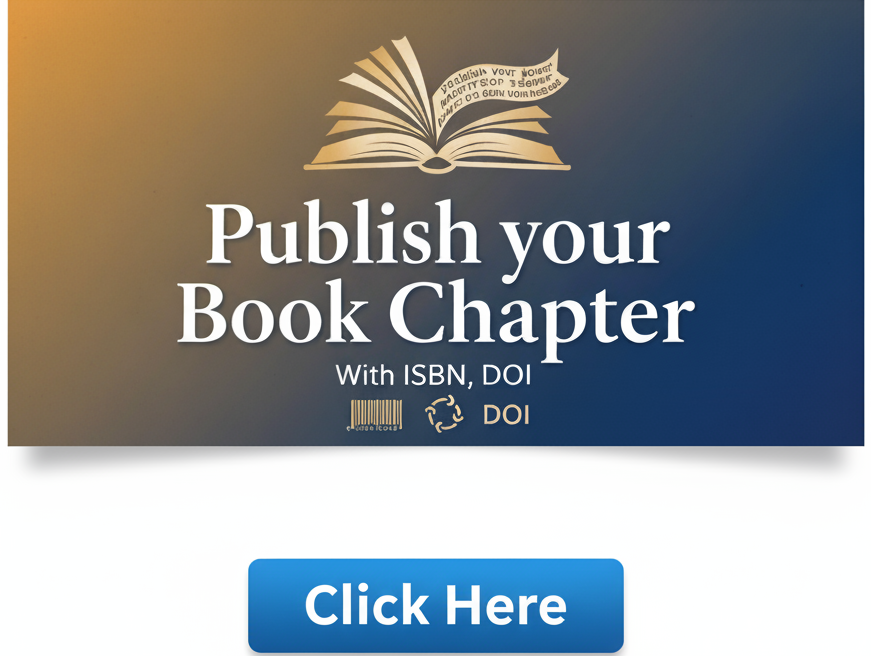Author's Guide
Submission of Manuscript
Authors should submit their manuscripts in electronic format (Microsoft Word document). Accepted papers will be acknowledged and processed further. Manuscripts will not be returned if rejected. If the author does not receive the status of the article within 45 days from the date of submission, they may inquire via email.
Authors must submit their articles in two separate documents:
- First Document: Contains the Title, List of Authors and Corresponding Author with their Email IDs.
- Second Document: Contains the remaining article text or body.
The acceptance or rejection of a manuscript will be decided by the Editorial Board based on the peer-review process.
Online submission system must be preferred.
Preparation of Manuscript
- Authors must specify the category of their article (Research Article, Short Communication, Review Article, Case Report) at the time of submission.
- The title page should include the full names, affiliations, and email IDs of all authors/co-authors.
- Manuscripts should be concise, with a total word count not exceeding 6000 words.
- Page numbers should appear in the lower right-hand corner of each page, starting with the title page.
- The manuscript must be written in clear and explicit English.
- To facilitate a double-blind review, the names of authors and any identifying details must not appear in the body of the manuscript.
We Accept Manuscripts under the Following Categories
- Research Articles
- Review Articles
- Case Reports/Studies
- Short Communications
Word Limit
The manuscript should follow the word limit according to its category (excluding the abstract):
- Research Article: 6000 words
- Short Communication: 3000 words
- Review Article: 5000 words
- Case Report/Study: 3000 words
Research Areas
Manuscripts may be submitted from the following broad research areas:
- Commerce & Trade:
Covering domestic and international trade practices, retail and wholesale management, export-import policies, digital commerce, supply chain practices and contemporary developments in commercial operations. - Business Strategy:
Encompassing strategic management, corporate planning, competitive intelligence, business transformation, innovation strategies, mergers and acquisitions, organizational restructuring, and crisis management. - Economics & Finance:
Spanning areas such as microeconomics, macroeconomics, development economics, international economics, financial markets, corporate finance, investment analysis, banking, insurance, taxation and accounting. - Management Studies:
Covering human resources, organizational behavior, leadership, operational excellence, quality management, project management and performance evaluation in public and private enterprises. - Marketing & Consumer Behavior:
Including marketing strategies, consumer insights, branding, digital marketing, sales management, market research, advertising and customer relationship management. - Entrepreneurship & Innovation:
Addressing new venture creation, entrepreneurial finance, family businesses, MSMEs, business incubators, innovation ecosystems, start-up strategy and social entrepreneurship. - International Business:
Focusing on foreign direct investment, global trade practices, international marketing, cross-border mergers, international business law and the impact of globalization on commerce and strategy. - Technology in Business:
Encompassing the use of AI, big data analytics, blockchain, information systems, digital transformation, FinTech and technological innovations influencing strategic business decisions. - Sustainability & Corporate Responsibility:
Exploring CSR practices, sustainable business models, ESG frameworks, green supply chains, business ethics and environmental accounting. - Interdisciplinary & Emerging Fields:
Research that integrates commerce and strategy with other disciplines such as law, public policy, education and digital governance, fostering innovation across multiple domains of applied research.
Originality
All submitted manuscripts must be original and not published or under review elsewhere. Authors must certify the originality of their work. Any instance of plagiarism, falsification, or duplication will lead to disqualification from future submissions.
Research Article Format
Manuscripts should be structured as follows:
- Title
- Authors' Full Names
- Affiliations & Email IDs
- Abstract (Max: 250 words)
- Keywords (Up to six)
- Introduction
- Materials and Methods/Experimental Section
- Statistical Analysis
- Results
- Discussion
- Conclusion
- Acknowledgments (if applicable)
- Conflict of Interest Declaration
- Funding & Author Contributions
- References
Title Page Format
- Title: Boldface, Title Case, Font Size 14 (Constantia)
- Authors' Names: Uppercase, Font Size 12
- Affiliations: Complete details with postal address and pin code
- Corresponding Author: Marked with an asterisk (*)
- Running Title: Should not exceed 50 characters
Abstract & Keywords
- The abstract should be informative, self-explanatory, and written in the past tense.
- Keywords (up to six) should be relevant and specific to the study.
Results & Discussion
- Results should be clear and concise, presented in past tense.
- The discussion should interpret findings in relation to prior research and highlight significant insights.
- Avoid repeating results in both text and graphical formats.
References
- References should be numbered in the order they appear in the text, using square brackets [1].
- Use APA/NLM Citation Style for reference formatting.
- Examples:
- Devi KV, Pai RS. Antiretrovirals: Need for an Effective Drug Delivery. Indian J Pharm Sci 2006;68:1-6.
- Norman IJ, Redfern SJ, editors. Mental Health Care for Elderly People. New York: Churchill Livingstone; 1996.
Tables & Figures
- Tables must be formatted in Microsoft Word with clear column separations.
- Figures should be high-resolution JPEG files with Arabic numeral captions.
- Tables/Figures must be placed within the text and not at the end of the document.
Author Contributions & Conflict of Interest
- Authors should specify their individual contributions to the research.
- Any potential conflicts of interest must be disclosed at the time of submission.
Language & Formatting Guidelines
- Use Calibri (12pt) for content and Constantia (14pt) for the title.
- Use TAB for paragraph indentation, not spaces.
- Manuscripts should be written in clear, professional English.
Licensing Policy
The Journal of Applied Commerce and Strategy follows Open Access Policy under the Creative Commons (CC BY-NC 4.0) license. Readers can read, download and share published articles for non-commercial purposes.
Rejection Appeals
Authors may appeal rejection decisions within 14 calendar days by emailing the Editor-in-Chief with supporting arguments. Appeals will be reviewed by the Editorial Board and, if successful, the manuscript may proceed through the review process.
For any queries, contact asia.j.commerce@gmail.com












